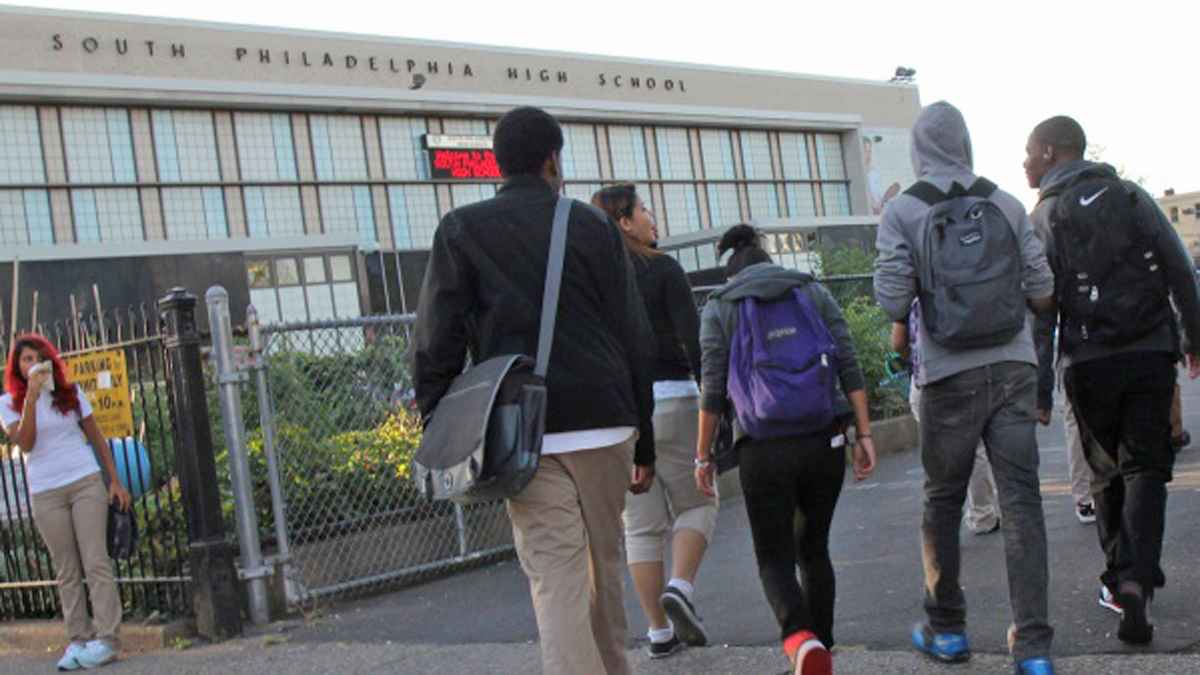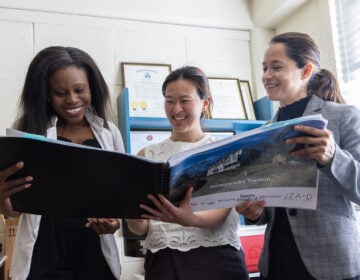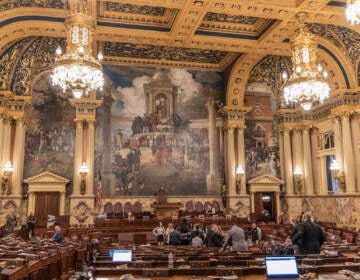Can Jim Kenney bring community schools to Philadelphia?
Listen
Students arrive for class at South Philadelphia High School (Kimberly Paynter/WHYY)
On a small plot of land wedged between South Philly High School’s parking lot and the sidewalk, Arielle Narva works with a seventeen-year-old named Kahlil to turn over soil in raised garden beds.
“This bed that Kahlil is working on right now, he’s kind of prepping it so we can plant tomatoes, hot peppers, all that summery stuff,” said Narva.
Narva said the garden has become a place for kids to congregate and learn during and after school. She described a biology and English Language Learner teacher taking his students to learn about the “life of a seed” in the garden, while also improving their English. Thanks to a partnership with the Philadelphia Horticultural Society, it will also give jobs to some students this summer.
Narva works for Sunrise of Philadelphia, Inc., a nonprofit that runs afterschool programing at two sites in the Philadelphia school district. It’s one of a menu of partners at South Philly high, which include a health center and groups offering mental health services, night classes for adults, credit recovery programs, among others.
Principal Otis Hackney said his school has to be different because its students are different.
“How this district works, and the number of high schools that we have and school choice…it concentrates types of students,” said Hackney, noting that there are magnet schools for the academically gifted students and arts schools for creative students.
There are also a lot of neighborhood schools like Southern. “What it does is it concentrates students with high needs,” he said. “So if I have high concentrations of students with high needs, I need to make sure I have high levels of support.”
What is a community school?
“High expectations with high support” is nearly a mantra for Hackney.
It’s this kind of thinking that gets advocates for community schools get excited. “Community schools” is a broad brush label for schools that co-locate medical care, social services and community educational resources in a school building. Having a single point-of-service keeps students from missing school for things like doctor’s appointments, and reaches families in need where they are.
The thinking goes that if you can address needs like poverty, adult literacy and health care in a neighborhood school, whole communities will benefit.
Nationally, Cincinnati, Ohio’s Community Learning Center model is the flagship of the community schools movement. Once declared Ohio’s worst school facilities by the federal government, Cincinnati now credits community schools with improving graduation rates.
The New York Times and some education reformers have noted that gains in overall academic performance in Cincinnati’s community schools are incremental, not necessarily the dramatic upswing needed to make the schools academically competitive.
Still, many in Philadelphia, from City Council President Darrell Clarke to the Philadelphia Coalition Advocating for Public Schools (PCAPS) view community schools as a way out of a stagnate, perpetual funding crisis that leaves students without supports.
Politicians, including Jim Kenney, like to point to South Philly and Otis Hackney as the way forward. At a mayoral forum this year, Kenney called out both by name.
“What we need is community schools. Schools that are the center of that community’s universe,” said Kenney. “A perfect example of that kind of institution is South Philadelphia High School and Otis Hackney…who has taken what was basically what was a troubled and dangerous school and turned it into a model for educational reform in our city.”
The thing is, without a city-wide definition for what a community school is, Hackney doesn’t think he’s running one. Many of the partnerships predate Hackney’s time as principal, and his staff coordinates all activities with partners.
“For us to truly be called a community school, the city would have to recognize it, the District would have to recognize it,” said Hackney. “But if you ask most folks downtown, whether it be the district office or city hall, they wouldn’t say South Philadelphia is a community school.”
Except, they do. “The definition for us of a community schools is a school in which a school leader, a principal, has specifically determined that there are specific partners and services that need to co-locate and serve his building,” said the District’s Chief of Student Services, Karyn Lynch. That definition is very different from the coordinated models in Cincinnati or Harlem.
This confusion about what community schools would mean in Philadelphia points to some historic stumbling blocks: money and lack of coordination.
Paying for community schools
At a recent community budget hearing held by the School District of Philadelphia at Northeast High School, a handful of attendees shared their funding questions with the District’s Chief Financial Officer Matt Stanski.
One woman, who did not give her name, mentioned visiting community schools in Ohio. “I was floored,” she said. “If communities themselves want to start [one], they talk to the principal of the school and they’re all on board to start a community school, where does that funding come from?”
“We would love it if the City of Philadelphia would want to partner with us in creating community schools,” School Reform Commission chairwoman Marjorie Neff chimed in from the audience. “But make no mistake about it…that’s not going to replace, that can’t be in lieu of, the money that the school’s need.”
In fiscally-distressed Philadelphia, to spend any money in the schools budget, you have to take it away from something else. Supporters of the community schools model insist that it’s not expensive and it more effectively uses existing resources.
The Cincinnati model leverages funding sources outside of the school district to bring in services. Medical providers can get reimbursed by Medicaid for services provided in schools, and foundation grants play a big part in funding non-medical partners. This is how it works at South Philadelphia High School, too.
Hackney and his staff keep spreadsheets, tracking each student’s participation in partner-operated services, to assist with grant reporting and to start to assess the value of programs as they relate to school attendance and performance.
Still, coordinating services between service providers and schools District-wide would cost something. Otis Hackney demurred to give a number for what it would take to bring his school up to par with national community schools. “I don’t want to be held to a number…but a couple of people to coordinate services that we have, that would be what we need.”
Many sides, one goal
In the 1990s, then superintendent David Hornbeck promoted partnerships to put more services in Philadelphia schools. Turnover in educational leadership and trends swept out these programs when he left that office.
Even if money were not an issue, community schools require sustainable cooperation between the district, city leadership, the teachers union and community organizations —groups that often at odds.
The district and the Philadelphia Federation of Teachers are locked in legal battle over an expired labor contract. As evidenced by a request for proposals released this month, the district’s attempts to bring in outside providers to offer medical services in schools circumvent organized workers like school nurses.
City Council president Darrell Clarke has also repeatedly voiced suspicion of the school district’s ability to direct programs. “The traditional role of sending the money to 440 North Broad, not having sense of how it’s directed, is troubling to me,” said Clarke.
At a hearing for his school-based family services proposal last year, the District’s Chief of Student Services Karyn Lynch pushed back against Clarke’s plan, saying the district had already laid much of the groundwork for adding services to schools. “The trust and respect among coordinating agencies cannot be directed or required…we respectfully request the City Council to support the district’s current efforts in school-based family services…and not create a new entity to do the same.”
In response, Clarke asked to District to provide data that its partnerships are effective. “If you’re sitting here today saying that you’re already doing everything, and ‘Thank you very much City Council, we already got that’,” said Clarke. “What I’m seeing here is, with all due respect, just the opposite.”
Politics and education policy can be difficult to separate in Philadelphia.
In the case of community schools, a lot of groups are at least superficially behind the idea.
When it comes to bringing these groups together, democratic mayoral nominee Jim Kenney says he’s the guy for the job. If elected, he’s proposed to make 25 neighborhood public schools into community schools in the next four years. “I want to be the point guard of this endeavour, calling the offense, calling all the plays and making the endeavour succeed as a team,” said Kenney.
And he said he’d find $8 million in the school district’s budget to pay for it.
WHYY is your source for fact-based, in-depth journalism and information. As a nonprofit organization, we rely on financial support from readers like you. Please give today.




